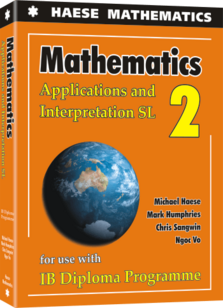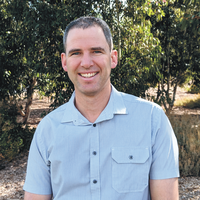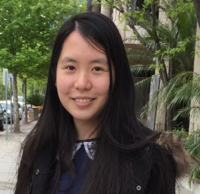Haese Mathematics Applications And Interpretation Sl 2 Pdf

Series: IB Diploma Programme
Mathematics: Applications and Interpretation SL
+
Physical & Digital Copy
ISBN: 978-1-925489-57-6
$52.80 Australia
(AUD including GST)
$48.00 International
(AUD excl. GST)
Digital Copy duration: 24 months
$36.96 Australia
(AUD including GST)
$33.60 International
(AUD excl. GST)
Digital Copy duration: 24 months
About the Book
For an online preview, please email IB@haesemathematics.com.
This book has been written for the IB Diploma Programme course Mathematics: Applications and Interpretation SL, for first assessment in May 2021.
This book is designed to complete the course in conjunction with the Mathematics: Core Topics SL textbook. It is expected that students will start using this book approximately 6-7 months into the two-year course, upon the completion of the Mathematics: Core Topics SL textbook.
This product has been developed independently from and is not endorsed by the International Baccalaureate Organization. International Baccalaureate, Baccalaureát International, Bachillerato Internacional and IB are registered trademarks owned by the International Baccalaureate Organization.
Year Published: 2019
Page Count: 504
ISBN: 978-1-925489-57-6 (9781925489576)
Online ISBN: 978-1-925489-69-9 (9781925489699)
Table of Contents
Mathematics: Applications and Interpretation SL
| 1 | APPROXIMATIONS AND ERROR | 15 | |
| A | Rounding numbers | 16 | |
| B | Approximations | 20 | |
| C | Errors in measurement | 22 | |
| D | Absolute and percentage error | 25 | |
| Review set 1A | 29 | ||
| Review set 1B | 30 | ||
| 2 | LOANS AND ANNUITIES | 31 | |
| A | Loans | 32 | |
| B | Annuities | 38 | |
| Review set 2A | 43 | ||
| Review set 2B | 44 | ||
| 3 | FUNCTIONS | 45 | |
| A | Relations and functions | 46 | |
| B | Function notation | 49 | |
| C | Domain and range | 53 | |
| D | Graphs of functions | 57 | |
| E | Sign diagrams | 60 | |
| F | Transformations of graphs | 63 | |
| G | Inverse functions | 69 | |
| Review set 3A | 73 | ||
| Review set 3B | 76 | ||
| 4 | MODELLING | 79 | |
| A | The modelling cycle | 80 | |
| B | Linear models | 86 | |
| C | Piecewise linear models | 89 | |
| D | Systems of equations | 94 | |
| Review set 4A | 96 | ||
| Review set 4B | 98 | ||
| 5 | BIVARIATE STATISTICS | 101 | |
| A | Association between numerical variables | 102 | |
| B | Pearson's product-moment correlation coefficient | 107 | |
| C | Line of best fit by eye | 112 | |
| D | The least squares regression line | 116 | |
| E | Spearman's rank correlation coefficient | 123 | |
| Review set 5A | 128 | ||
| Review set 5B | 130 | ||
| 6 | QUADRATIC FUNCTIONS | 133 | |
| A | Quadratic functions | 135 | |
| B | Graphs from tables of values | 137 | |
| C | Axes intercepts | 139 | |
| D | Graphs of the form $y = ax^2$ | 141 | |
| E | Graphs of quadratic functions | 143 | |
| F | Axis of symmetry | 144 | |
| G | Vertex | 147 | |
| H | Finding a quadratic from its graph | 149 | |
| I | Intersection of graphs | 152 | |
| J | Quadratic models | 153 | |
| Review set 6A | 159 | ||
| Review set 6B | 161 | ||
| 7 | DIRECT AND INVERSE VARIATION | 163 | |
| A | Direct variation | 164 | |
| B | Powers in direct variation | 168 | |
| C | Inverse variation | 170 | |
| D | Powers in inverse variation | 172 | |
| E | Determining the variation model | 173 | |
| F | Using technology to find variation models | 175 | |
| Review set 7A | 178 | ||
| Review set 7B | 180 | ||
| 8 | EXPONENTIALS AND LOGARITHMS | 183 | |
| A | Exponential functions | 185 | |
| B | Graphing exponential functions from a table of values | 186 | |
| C | Graphs of exponential functions | 187 | |
| D | Exponential equations | 191 | |
| E | Growth and decay | 192 | |
| F | The natural exponential | 199 | |
| G | Logarithms in base $10$ | 204 | |
| H | Natural logarithms | 208 | |
| Review set 8A | 211 | ||
| Review set 8B | 213 | ||
| 9 | TRIGONOMETRIC FUNCTIONS | 217 | |
| A | The unit circle | 218 | |
| B | Periodic behaviour | 221 | |
| C | The sine and cosine functions | 224 | |
| D | General sine and cosine functions | 226 | |
| E | Modelling periodic behaviour | 231 | |
| Review set 9A | 236 | ||
| Review set 9B | 239 | ||
| 10 | DIFFERENTIATION | 241 | |
| A | Rates of change | 243 | |
| B | Instantaneous rates of change | 247 | |
| C | Limits | 251 | |
| D | The gradient of a tangent | 252 | |
| E | The derivative function | 254 | |
| F | Differentiation | 256 | |
| G | Rules for differentiation | 259 | |
| Review set 10A | 265 | ||
| Review set 10B | 267 | ||
| 11 | PROPERTIES OF CURVES | 269 | |
| A | Tangents | 270 | |
| B | Normals | 273 | |
| C | Increasing and decreasing | 276 | |
| D | Stationary points | 280 | |
| Review set 11A | 284 | ||
| Review set 11B | 285 | ||
| 12 | APPLICATIONS OF DIFFERENTIATION | 287 | |
| A | Rates of change | 288 | |
| B | Optimisation | 293 | |
| C | Modelling with calculus | 301 | |
| Review set 12A | 303 | ||
| Review set 12B | 304 | ||
| 13 | INTEGRATION | 307 | |
| A | Approximating the area under a curve | 308 | |
| B | The Riemann integral | 313 | |
| C | The Fundamental Theorem of Calculus | 317 | |
| D | Antidifferentiation and indefinite integrals | 320 | |
| E | Rules for integration | 322 | |
| F | Particular values | 324 | |
| G | Definite integrals | 325 | |
| H | The area under a curve | 328 | |
| Review set 13A | 331 | ||
| Review set 13B | 333 | ||
| 14 | DISCRETE RANDOM VARIABLES | 335 | |
| A | Random variables | 336 | |
| B | Discrete probability distributions | 338 | |
| C | Expectation | 342 | |
| D | The binomial distribution | 347 | |
| E | Using technology to find binomial probabilities | 352 | |
| F | The mean and standard deviation of a binomial distribution | 355 | |
| Review set 14A | 357 | ||
| Review set 14B | 358 | ||
| 15 | THE NORMAL DISTRIBUTION | 361 | |
| A | Introduction to the normal distribution | 363 | |
| B | Calculating probabilities | 366 | |
| C | Quantiles | 373 | |
| Review set 15A | 377 | ||
| Review set 15B | 378 | ||
| 16 | HYPOTHESIS TESTING | 381 | |
| A | Statistical hypotheses | 382 | |
| B | Student's $t$-test | 384 | |
| C | The two-sample $t$-test for comparing population means | 393 | |
| D | The$\chi^2$ goodness of fit test | 395 | |
| E | The$\chi^2$ test for independence | 405 | |
| Review set 16A | 413 | ||
| Review set 16B | 415 | ||
| 17 | VORONOI DIAGRAMS | 417 | |
| A | Voronoi diagrams | 418 | |
| B | Constructing Voronoi diagrams | 422 | |
| C | Adding a site to a Voronoi diagram | 427 | |
| D | Nearest neighbour interpolation | 431 | |
| E | The Largest Empty Circle problem | 433 | |
| Review set 17A | 437 | ||
| Review set 17B | 439 | ||
| ANSWERS | 441 | ||
| INDEX | 503 | ||
Authors
- Michael Haese
- Mark Humphries
- Chris Sangwin
- Ngoc Vo
Features
-
Snowflake (24 months)
A complete electronic copy of the textbook, with interactive, animated, and/or printable extras.
-
Self Tutor
Animated worked examples with step-by-step, voiced explanations.
-
Theory of Knowledge
Activities to guide Theory of Knowledge projects.
-
Graphics Calculator Instructions
For Casio fx-CG50, TI-84 Plus CE, TI-nspire, and HP Prime
This book offers SELF TUTOR for every worked example. On the electronic copy of the textbook, access SELF TUTOR by clicking anywhere on a worked example to hear a step-by-step explanation by a teacher. This is ideal for catch-up and revision, or for motivated students who want to do some independent study outside school hours.
Graphics calculator instructions for Casio fx-CG50, TI-84 Plus CE, TI-nspire, and HP Prime are included with this textbook. The textbook will either have comprehensive instructions at the start of the book, specific instructions available from icons located throughout, or both. The extensive use of graphics calculators and computer packages throughout the book enables students to realise the importance, application, and appropriate use of technology.
Theory of Knowledge is a core requirement in the International Baccalaureate Diploma Programme.
Students are encouraged to think critically and challenge the assumptions of knowledge. Students should be able to analyse different ways of knowing and kinds of knowledge, while considering different cultural and emotional perceptions, fostering an international understanding.

This book is available on electronic devices through our Snowflake learning platform. This book includes 24 months of Snowflake access, featuring a complete electronic copy of the textbook.
Where relevant, Snowflake features include interactive geometry, graphing, and statistics software, demonstrations, games, spreadsheets, and a range of printable worksheets, tables, and diagrams. Teachers are provided with a quick and easy way to demonstrate concepts, and students can discover for themselves and re-visit when necessary.
Support material
-
Errata
Last updated - 03 Mar 2021
Related Products
Haese Mathematics
Proudly Supports



- Haese Publications
- International Baccalaureate (IB)
- Australian Curriculum
- Cambridge Assessment International Education
- UK Curricula
- Mathematics Dictionary
- The Mathematics Book [published by Zenolith]
- Previous Editions and Clearances
- Digital Books
- Infinity Question Generators
- Snowflake Online Learning
- Support
- Errata
- FAQs
- News & Events
- About Us
- Contact
- Snowflake Login
Haese Mathematics
Mailing List
SUBSCRIBE: Register your interest for information related to Haese Mathematics products
Haese Mathematics Applications And Interpretation Sl 2 Pdf
Source: https://www.haesemathematics.com/books/mathematics-applications-and-interpretation-sl
Posted by: johnsonalitels.blogspot.com





0 Response to "Haese Mathematics Applications And Interpretation Sl 2 Pdf"
Post a Comment